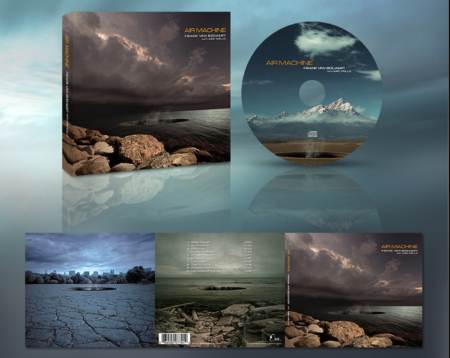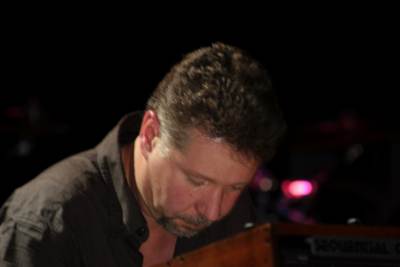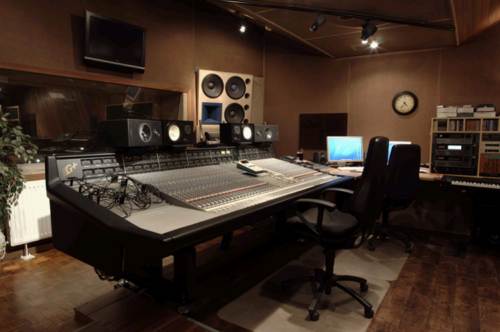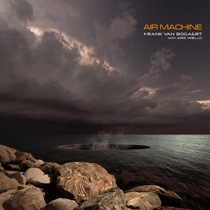|

Frank, when and how did “Air Machine”, which is actually your first concept-album, take shape?
I started working on this project by the beginning of 2007, almost right after the release of the previous album “Nomads”.
So “Air Machine” took about two years (or even more) to write and record.
Though the concept got more detailed as the music was written, it was there from the start.
“Air Machine” is all about seeing our planet in a metaphorical way as a failing air production machine.
So yes, you could say it’s about the environmental issue but without wanting to be a “green prophet”.
What approach did you have in mind for the music, which takes a slight side-step from the music you made until now?
Well, first of all, I really wanted it to be different to what I’d done before.
I felt now was the time to change course, but I had to do this without losing or even try to change my way of composing music.
I realized that otherwise a lot of fans would be disappointed.
But I needed to change my approach to the actual making of the music.
With “Nomads” I felt I had gone as far as I could with the concept of being a one man synth/keyboard band, so the most obvious thing for the “Air Machine” album was to get other musicians in: not only playing what I wanted, what I had in mind, but giving them creative input.
Renewing yourself, or at least trying to, is not always easy but it is a challenge you have to go for if you take your work seriously.
You otherwise may become a copycat of your own work and things will get very boring.
In the end, I’m very proud that “Air Machine” sounds so different but still is very recognizable as Van Bogaert recording.

For the album, you invited Erik Wøllo as a guest musician. How did you two get in touch, what ideas did come from his side?
Erik and I were already mailing each other for years before we started working together.
When I got hold of his album “Emotional Landscape”, I immediately liked his way of playing the guitar, his atmosphere building and most of all, his trademark sound.
Since then we’ve been sending each other our latest releases.
At one time, Erik proposed to me that if I ever needed guitars on my work he’d be happy to play them.
But it wasn’t till “Air Machine” that I felt the need for it.
So Erik and I did meet at E-live 2007 to discuss things. I told Erik I was starting work on a new album on which I thought he would nicely fit in.
A bit later I did send him a first track (which was actually “Insomnia”) and gave no directions.
“Erik, just do what you think is needed on this track and take your time for it, Greetz, Frank” was all.
When I got Erik’s parts send back to my studio, I immediately realized his and my style did match together without one of us having to give in.
The result was just stunningly beautiful.
In my opinion, the music and mix on “Air Machine” has a rather complex character, although remaining dynamic and transparent. So how tough was it to get to this outcome?
It is indeed much more complex because more different instruments were involved.
There was a lot of live drumming and percussion going on by studio session musicians, which had to be mixed nicely with my percussion and drum programming.
This element is something that always has been very important in my music.
On my own website, one can look at a short film snippet of one of the drum recording sessions for “Air Machine”, located in the media section.
Then there’s Erik’s sonically rich guitars had to be put in and they certainly demand their place in a mix, and then there’s that wall of keyboards of me …..
But the great thing about it is that, though it was certainly more complex to mix, the music does sound more open and more relax.
Certainly when compared to some of my more big orchestral arrangements on previous releases.

Frank, what did you learn during the creation of the album?
That it felt really good getting the input of other musicians and that it was a good thing to change my way of working.
I think future releases will all have this in common.
Also, on “Air Machine”, one can really feel and hear the progressive rock influences.
Besides me being a producer specialized in that style, it proved to me that I can make electronic music and progressive rock walk ‘hand in hand’ without losing my identity.
Please tell some more about the instruments and the additional technical tuff you used
Woops, I hope you’re not to busy the next couple of hours…..
I always like to see my whole ACE Studio, of which I’m the manager, as one single instrument to create my music (and that of others), but lets talk about the real stars on “Air Machine”
The Moog Voyager was a lot in use, I just love that machine.
Apart from the track “Cold Steel”, I tried to get sounds out of it that weren’t immediately recognizable as being Moog, you know. That’s something you can’t achieve with the traditional Minimoog.
The Prophet 5 has also contributed a lot. This one is after all these years still a surprisingly original beast to work with.
Of course my other analogs were also involved, but I must admit having also used a lot of virtuals like the CS80V, Absynth, the Spectrasonics stuff , different sample libraries etc…
Everything is programmed into Logic Pro, but all the actual recording is done into Protools.
But I think the most important instrument off all is the mixing desk in the studio. This is where a lot of home studio productions fail: having a real mixing desk, having great dynamic and effects processors, and knowing what you can achieve with it.
Half of the album was mixed on my old Amek desk and the other half on the lately installed SSL4000G+, which is now the centerpiece of the studio.
I suggest that you have a look at the studio website www.acestudio.be to know everything about the gear I’m using, it’s all listed there.

The beautiful cover art to the album is some great icing on the cake as well. What’s there to tell about it and its designer?
Yes, I agree. I’ve always thought a good sleeve design is very important.
It’s your first impression of an album before you’ve heard it, isn’t it ?
I‘ve come to the conclusion that most of the time a great sleeve design also means that the music has been made with great care, it’s not always 100% foolproof, but still.
I’ve discovered a lot of great bands that were unknown to me just because I was intrigued by their sleeve artwork.

The other way round is also true, very often poor sleeve design already reflects poorly made music.
So when I got hold of an album of US proggers Glass Hammer, I liked their sleeve design that much that I contacted their designer Michal Karcz.
He was very interested in designing the cover of “Air Machine”, being inspired by its concept, so I was convinced he was the right guy to do the job
Even his early rough designs for “Air Machine” were already looking great.
He’s an artist in the vein of Hipgnosis. His signature has that mystic and abstract element, but at the same time beautiful thing in his designs.
The fact that he’s also a big fan of ambient and electronic music made life easier.
A pure coincidence was that at the same time he was also designing the cd-cover for Steve Roach’s latest release “Dynamic Stillness”, and as Erik Wøllo had just collaborated with Steve, there was a special link.
When you compare this album to your other works, where and how does it fit in?
I think this is the one I’m most proud of.
The compositions, the overall atmospheres, the production, Erik’s work, it all makes it more appealing to people who are not necessarily electronic music fans. Saying that, I’m still very fond of “Nomads” and “Docking”.
Yes I think these are my top 3 albums.
“Air Machine” is released an Ace Studio-release and not through Groove Unlimited. Any particular reason for that?
The main reason is financial.
“Air Machine” has been the most expensive release up till now, with professional guest musicians, expensive artwork, digi-pack sleeve, more studio time needed etc…
This is all being financed by myself and would be as good as not recoupable on royalties alone if being released by Groove.
In the days that cd sales were in the orders of many thousands, that wouldn’t have been a problem, but nowadays we open a bottle of Champaign if the figure one thousand gets into view.
Thus also for Groove it would be too much of a risk if they were to pay all the production costs.
I discussed this all with Ron Boots and we both agreed it was the best thing to do.
Groove Unlimited does still distribute the album to their customers and so our relationship is still very good.
This just to be ahead of any gossip.
On your site, I read that making “Air Machine” has paved the way for further collaborations with Mr Wøllo. So what do you and Erik have in mind?
Yes, we’ve certainly decided to continue working together, as we have started work on a Wøllo /Van Bogaert album.
We’ve only begun working on a first track now, but we’ve already agreed that we’ll be producing a more acoustic and ambient-oriented album .
We’ll compose every track together based on both our main instrument, being the guitar for Erik and the piano for me.
And we will stay far away from cheesy New age territories which could be a pitfall if you compose this way.
Anyway, we’ve also agreed to take the time necessary to make a very good album, nothing less !
Let’s talk about this once more in about, let’s say, within two years or so…..
Anything else you like to share on the making-of….
Nope, just buy the album if you like our music and want us to make some more. We also need to keep on being motivated, don’t we ?
Website: www.frankvanbogaert.com |





